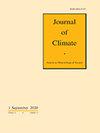由蜿蜒的南极环极洋流锚定的深冬混合层:跨流域变化
IF 4
2区 地球科学
Q1 METEOROLOGY & ATMOSPHERIC SCIENCES
引用次数: 0
摘要
摘要 南极环极洋流(ACC)以北的印度洋-太平洋海域形成了较深的冬季混合层,而大西洋的混合层深度(MLD)较浅。本研究利用观测数据和全球大气模式,研究了表层浮力通量和背景分层对海盆间混合层深度变化的影响。地表热通量分为宽尺度和锋面尺度变化。在大尺度上,ACC 的蜿蜒路径伴随着海面温度的带状波数-1 结构,太平洋比大西洋更热;在盛行西风的情况下,这种温度对比导致了更大的海面热量损失,使印度洋-太平洋扇区的 MLD 比大西洋更深。与太平洋相比,印度洋扇区强烈的 ACC 锋面加剧了表层热量损失。地表淡水通量模式与蒸发模式基本一致,并加强了热通量模式,尤其是在东南太平洋。引入了一种诊断关系,以强调 ACC 倾斜等压线在 ACC 以北形成弱亚混合层分层的作用。这种弱分层现象在各海盆的程度不同。在大西洋和西印度洋,ACC 位于低纬度(南纬 45 度),太阳加热、副热带涡旋侵入和高能中尺度涡流共同维持了相对较强的分层。相比之下,在东南太平洋,ACC 到达最南端纬度(56°S),远离副热带锋面。这就造成了较弱的分层,使深层混合层在表面浮力损失的帮助下得以形成。本文章由计算机程序翻译,如有差异,请以英文原文为准。
Deep winter mixed layer anchored by the meandering Antarctic Circumpolar Current: Cross-basin variations
Abstract A deep winter mixed layer forms north of the Antarctic Circumpolar Current (ACC) in the Indo-Pacific sectors, while the mixed layer depth (MLD) is shallow in the Atlantic. Using observations and a global atmospheric model, this study investigates the contribution of surface buoyancy flux and background stratification to inter-basin MLD variations. The surface heat flux is decomposed into broad-scale and frontal-scale variations. At the broad-scale, the meandering ACC path is accompanied by a zonal wavenumber-1 structure of sea surface temperature with a warmer Pacific than Atlantic; under the prevailing westerly winds, this temperature contrast results in larger surface heat loss facilitating deeper MLD in the Indo-Pacific sectors than the Atlantic. In the Indian sector, the intense ACC fronts strengthen surface heat loss compared to the Pacific. The surface freshwater flux pattern largely follows that of evaporation and reinforces the heat flux pattern, especially in the southeast Pacific. A diagnostic relationship is introduced to highlight the role of ACC’s sloping isopycnals in setting a weak sub-mixed-layer stratification north of ACC. This weak stratification varies in magnitude across basins. In the Atlantic and western Indian oceans where the ACC is at a low latitude (∼45°S), solar heating, intrusions of subtropical gyres and energetic mesoscale eddies together maintain relatively strong stratification. In the southeast Pacific, in comparison, the ACC reaches the southernmost latitude (56°S), far away from the subtropical front. This creates weaker stratification allowing deep mixed layers to form, aided by surface buoyancy loss.
求助全文
通过发布文献求助,成功后即可免费获取论文全文。
去求助
来源期刊

Journal of Climate
地学-气象与大气科学
CiteScore
9.30
自引率
14.30%
发文量
490
审稿时长
7.5 months
期刊介绍:
The Journal of Climate (JCLI) (ISSN: 0894-8755; eISSN: 1520-0442) publishes research that advances basic understanding of the dynamics and physics of the climate system on large spatial scales, including variability of the atmosphere, oceans, land surface, and cryosphere; past, present, and projected future changes in the climate system; and climate simulation and prediction.
 求助内容:
求助内容: 应助结果提醒方式:
应助结果提醒方式:


